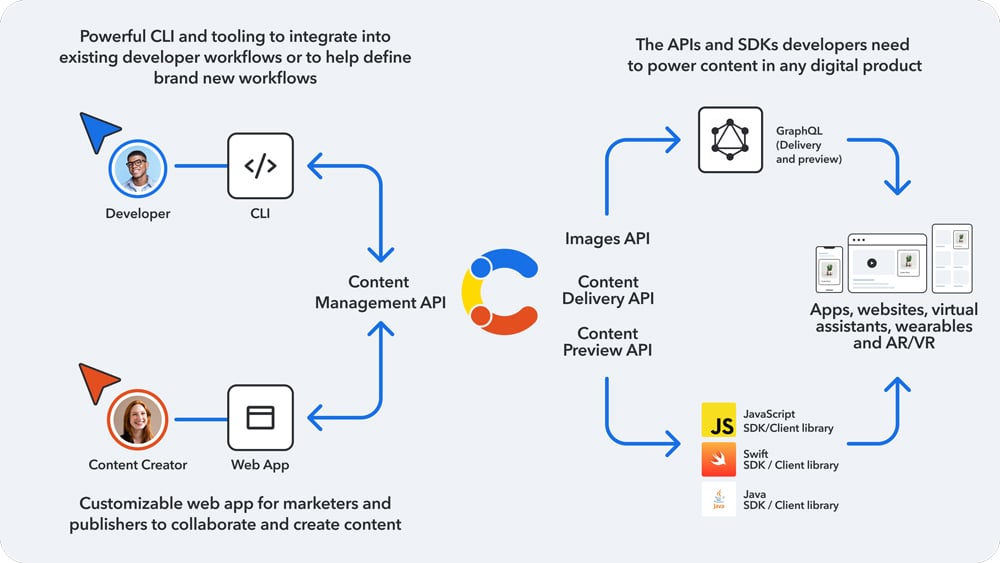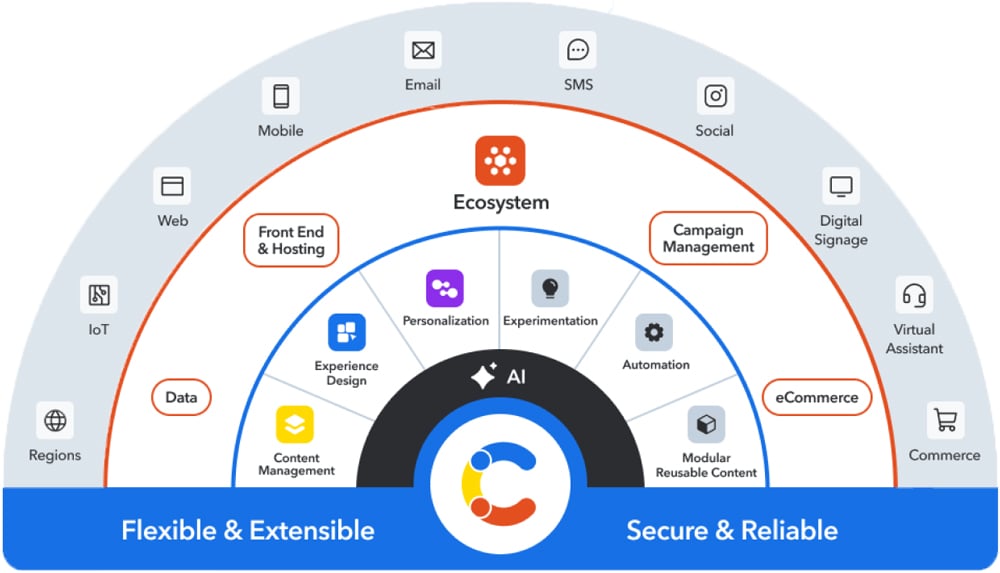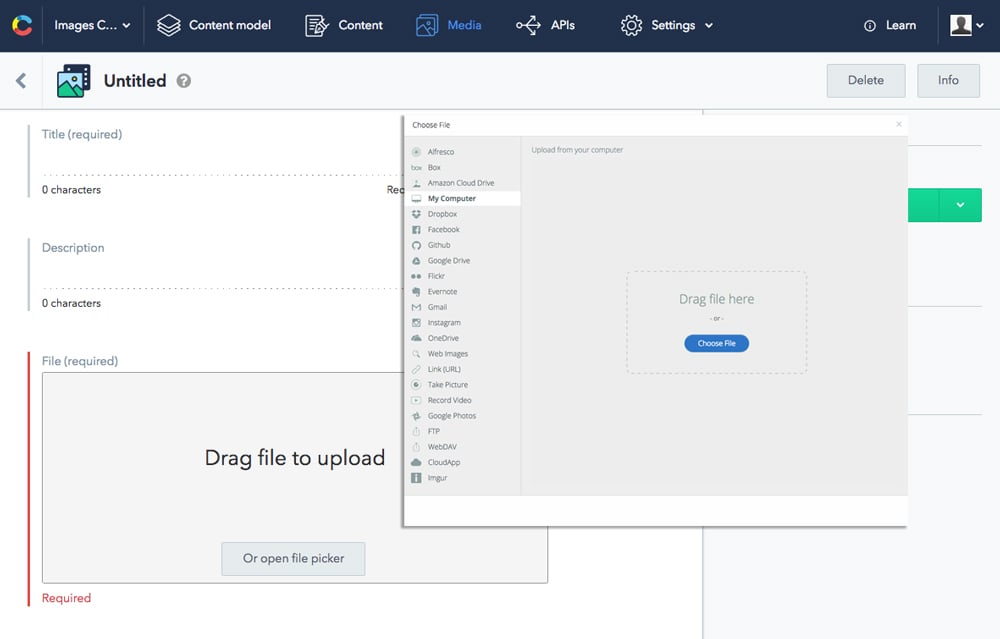Imagine your website’s words and pictures as separate ingredients, ready to be used in countless recipes. That’s the power of Contentful, a modern system that breaks free from old-fashioned website builders. This approach lets us manage content in one place and display it anywhere - websites, phone apps, smart displays, you name it!
But like any powerful tool, Contentful works best in skilled hands. While it’s easy for writers and editors to use, the tech experts are the ones who truly unlock its potential. They understand how to organize the content, connect it to different tools, and fine-tune its performance. As a trusted Contentful partner, we help clients implement these best practices to optimize content delivery. Let’s ready for Contentful best practices with insights we got from Duong Tran - our Contentful certified professional who has implemented Contentful for various clients.
Contentful CMS introduction
So, what exactly is Contentful CMS? Shall we pull back the curtain and explore what makes Contentful a true trailblazer?
Contentful: The central hub for your digital story
Contentful is a prime example of a headless CMS. The term “headless” might sound technical, but it’s the key to Contentful’s magic. Picture a traditional CMS as a statue, the “body” (content) inseparable from the “head” (how it looks on the website). Contentful, in its wisdom, separates these two.
At its core, Contentful is a platform where you create, manage, and organize your content in a structured way - a central content repository. This content is then delivered through versatile pathways called APIs - the digital arteries that feed information to any number of “faces,” be it your website, a mobile app, a voice assistant, you name it! It’s about creating content once and letting it live, breathe, and adapt across your entire digital ecosystem.
 Manage your content with Contentful APIs
Manage your content with Contentful APIs
Unlocking the power of Contentful: Key benefits
Stepping into the world of headless with Contentful unlocks a treasure trove of benefits:
- Omnichannel delivery: Content can be easily distributed across various platforms and devices (websites, mobile apps, smart displays, etc.) through its API, ensuring a consistent brand experience everywhere.
- Developer flexibility: Developers have the freedom to use their preferred programming languages, framework, and tools for the frontend. Contentful supports this flexibility with comprehensive resources like quick start guides, videos, and tutorials tailored to various popular tech stacks.
- Scalability and performance: Built on a modern cloud infrastructure, Contentful is highly scalable to handle growing content needs and delivers content quickly and reliably to end-users globally.
- Content structure and reusability: Content is organized into modular, reusable components, making it easier to manage, update, and repurpose information across different channels, saving time and ensuring consistency.
 A structured content tree
A structured content tree
- Extensive integration capabilities: Contentful seamlessly integrates with a wide range of other tools and services, such as Commerce platforms, marketing automation systems, analytics tools, and AI-powered services, creating a powerful and connected digital ecosystem.
 Contentful ecosystem
Contentful ecosystem
Why technical expertise matters in Contentful CMS implementation
Contentful: it’s got that sleek, user-friendly vibe, right? While that accessibility is a definite plus, unlocking its full potential requires more than drag-and-drop entries. Indeed, you need to tap into the expertise of your technical team.
Their role isn’t just to set things up - they architect the entire content infrastructure. From designing flexible, reusable content models to building fast, reliable API connections across channels, they ensure Contentful runs like a well-oiled machine. They also streamline workflows, integrate third-party tools, and enable automation that boosts productivity across teams.
And let’s talk about performance, scalability, and security - the pillars of a strong Contentful CMS environment. Your tech team, with best practices in hand, makes these critical elements a reality. The practices, which will be listed out below, aren’t just nice-to-haves but are the backstage magic that turns your digital presence into a lasting success.
Top 9 Contentful CMS best practices for developers
So, how do developers really get the most out of Contentful? It all comes down to applying the right strategies.
With in-depth understanding and mastery of the platform, our Contentful-certified expert - Duong Tran, has shared his practical and actionable advice to help developers build smarter - not harder - Contentful solutions.
1. Utilize Contentful’s CDN for fast content delivery
Contentful delivers content through a global Content Delivery Network (CDN) by default, reducing latency by serving data from the nearest server to your users. Developers should ensure their applications fully leverage this setup to provide fast, smooth, and globally consistent user experiences.
2. Use GraphQL for efficient data retrieval
Instead of rigid REST API calls that might fetch too much or too little data, embrace GraphQL. This powerful query language allows developers to request exactly the data needed, no more, no less. This efficiency optimizes network requests, speeds up content loading, and simplifies frontend development.
 A GraphQL request from a client device. Source: Contentful
A GraphQL request from a client device. Source: Contentful
3. Manage multiple environments (development, staging, QA, production)
Treat your Contentful space like a well-oiled machine with distinct stages: development, staging, QA, and production. Managing these separate environments allows developers to build, test, and approve new features or content changes without impacting the live experience, ensuring smoother rollouts, reducing risks, and also enhancing collaboration across teams. Contentful supports up to 151 environments per space, facilitating robust version control and deployment strategies.
4. Set up reusable and flexible content types
Think long-term. Developers should meticulously design content types that are modular, semantic, and reusable on different platforms and for future needs. This upfront effort prevents content duplication, simplifies maintenance, and enables true omnichannel delivery.
5. Enforce consistent naming conventions for content types and fields
A clean codebase starts with clear naming. Developers must establish and enforce consistent naming conventions for content types, fields, and assets. This seemingly small detail dramatically improves readability, collaboration, and maintainability for any team working on the project.
6. Integrate and optimize media asset handling (images, videos)
Digital experiences thrive on rich media. By exploiting Contentful’s asset management tools, developers can organize, optimize, and serve media efficiently across platforms and screen sizes.
 Create, process, edit assets on Contentful. Source: Contentful
Create, process, edit assets on Contentful. Source: Contentful
7. Optimize assets with techniques such as compression and lazy loading
Improve performance by compressing images to reduce file size without sacrificing quality, and use lazy loading to defer off-screen assets. These practices drastically cut load times and enhance UX, especially on mobile.
You can absolutely nail image loading by pairing lazy loading with Low-Quality Image Placeholders (LQIP). The awesome part is that Contentful's Image API makes generating those instant, blurred LQIP images a breeze, leading to a much smoother experience for your visitors!
 LQIP for fast loading. Source: Internet
LQIP for fast loading. Source: Internet
8. Implement webhooks to automate workflows and updates
Webhooks are Contentful’s secret sauce for automation. Leveraging webhooks triggers actions - like cache invalidation, CI/CD builds, or notifications - in external systems whenever content changes. In this way, workflows are streamlined, time is saved, and content stays synchronized across platforms in real time.
 Using webhooks in Contentful. Source: Contentful
Using webhooks in Contentful. Source: Contentful
9. Utilize Contentful’s built-in applications to boost productivity
- Contentful Merge: This tool lets you easily manage content model changes across different environments, like moving updates from UAT to Master, cutting down on manual syncing errors, and significantly speeding up your deployment process.
- Contentful Compose & Contentful Launch: Contentful Compose allows you to configure nested content views, giving editors a familiar, page-like interface. Paired with Contentful Launch, which enables one-click publishing of multiple related items, this combination ensures cleaner and more efficient content delivery for everyone involved.
Real-world examples
Curious to see Contentful CMS in action? We're bringing you a real success story we did for a leading brewing company with Contentful.
Struggling with the legacy WordPress CMS, the client chose Niteco as their trusted partner helping them move to Contentful platform while making their CMS have extended features beyond Contentful’s out-of-the-box capabilities.
How we managed the project
With our CMS implementation experience, we applied Contentful’s composable content model to create structured, reusable content types. This allowed editors to manage and publish content efficiently and consistently.
For added out-of-the-box capabilities integration, we have a clear approach and smooth implementation.
- Event Expiration Reminder: Using Contentful’s API-first architecture, we implemented an Azure Function to automate content reminders, enhancing editorial oversight.
- DAM integration: We built a custom Contentful App to connect to Aquia DAM. Editors can browse and select approved media assets directly within Contentful.
And the outcomes?
We introduced a structured content architecture including clear separation between pages and blocks, each based on defined types:
- Blocks are reusable content units stored and versioned independently or as part of a page
- Pages assemble these blocks, supporting templating and inheritance for efficient reuse.
We also implemented hierarchical URLs to address the challenge of Contentful’s flat content structure, providing SEO-friendly paths without compromising flexibility.
And finally, we made multibrand theming and templating for the client.
- Frontend: A shared core with theme-based overrides lets each brand customize its look (fonts, colors, layout) while reusing a unified codebase.
- Backend: Page and block templates dynamically adapt styling based on brand theme, ensuring design consistency across multiple sites.
'The whole project has been top-notch and the quality you've delivered is fantastic!' - That's the feedback we got from our client after implementing our Contentful-based solutions.
As a Silver Contentful partner with 29 certified experts, we know the platform inside out. We’re eager to help your business fully leverage the platform.
Conclusion
Now’s the time to start implementing these techniques to future-proof your Contentful setup and maximize its capabilities. Every enhancement matters, whether for new or existing projects.
Dive deeper: find more technical resources, engage in developer forums, or join the community of Contentful builders. For expert support, contact us.
FAQs about Contentful CMS and best practices
Yes, Contentful is widely considered a very good CMS, particularly for modern digital projects requiring flexibility, scalability, and omnichannel delivery. Its headless architecture makes it ideal for businesses needing to publish content across various platforms like websites, mobile apps, and IoT devices, offering developers freedom and content teams powerful management tools.
The default environment in Contentful is typically named “master.” This serves as the primary environment for your live, published content. Users can also create additional environments (e.g., development, staging) for testing and content workflows before publishing to “master.”
Contentful’s default limits can vary based on your plan (Community, Team, Premium, Enterprise). However, common initial default limits include:
- Content types: A specific number (e.g., 100 for some plans).
- Locales: A certain number of languages supported.
- API requests: A rate limit for API calls per second/minute.
- Assets: Storage limits for media files. It's always best to check Contentful's official pricing or plan details for the most up-to-date and specific default limits.
Best practices include leveraging Contentful's extensive API-first approach and webhooks. Use the Content Delivery API (CDA) for fetching content and the Content Management API (CMA) for managing it. Implement webhooks to trigger actions in other tools (e.g., build new deploys, clear caches, send notifications) whenever content changes.
To optimize performance:
- Implement a CDN (Content Delivery Network): For fast asset delivery.
- Cache API responses: Reduce repetitive calls to Contentful APIs.
- Use efficient queries: Fetch only the content you need, leveraging “include” and “select” parameters.
- Optimize images and media: Compress and serve them in appropriate formats.
Key security measures include:
- Strong API key management: Never expose management API keys client-side.
- Role-Based Access Control (RBAC): Assign minimal necessary permissions to users.
- Regular security audits: Review user roles and access settings.
- Use secure authentication methods: Implement SSO if available.
- Keep SDKs and libraries updated: To benefit from security patches.
- Monitor API usage: Detect unusual activity.
Contentful itself is highly scalable on the backend. Structure content models carefully, use modular content types, implement localization strategies early, and plan for content versioning and multi-environment workflows to support long-term growth.
